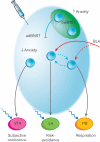Circuit dynamics of adaptive and maladaptive behaviour
- PMID: 24429629
- PMCID: PMC4069282
- DOI: 10.1038/nature12982
Circuit dynamics of adaptive and maladaptive behaviour
Abstract
The recent development of technologies for investigating specific components of intact biological systems has allowed elucidation of the neural circuitry underlying adaptive and maladaptive behaviours. Investigators are now able to observe and control, with high spatio-temporal resolution, structurally defined intact pathways along which electrical activity flows during and after the performance of complex behaviours. These investigations have revealed that control of projection-specific dynamics is well suited to modulating behavioural patterns that are relevant to a broad range of psychiatric diseases. Structural dynamics principles have emerged to provide diverse, unexpected and causal insights into the operation of intact and diseased nervous systems, linking form and function in the brain.
Figures


References
-
- Deisseroth K. Optogenetics and psychiatry: applications, challenges, and opportunities. Biol. Psychiatry. 2012;71:1030–1032. - PubMed
-
- Abbott A. Novartis to shut brain research facility. Nature. 2011;480:161–162. - PubMed
-
- Deisseroth K. Controlling the brain with light. Sci. Am. 2010;303:48–55. - PubMed
Publication types
MeSH terms
Grants and funding
LinkOut - more resources
Full Text Sources
Other Literature Sources
Medical

